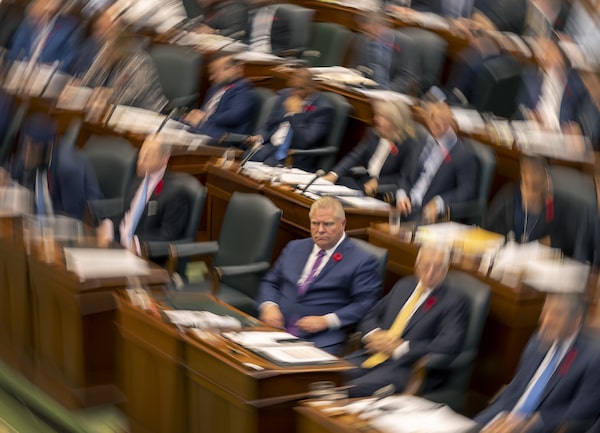
Ontario Premier Doug Ford sits in the Ontario Legislature during Question Period on Nov. 1, as members debate a bill meant to avert a planned strike by 55,000 education workers.Frank Gunn/The Canadian Press
Google “notwithstanding clause,” and you will come across a reassuring article in the Canadian Encyclopedia.
The clause, it explains, was included in the Charter of Rights and Freedoms as part of a last-minute deal in 1981 to patriate the Constitution: “Also known as the override clause, it … allows federal, provincial or territorial governments to temporarily override, or bypass, certain Charter rights.”
That might sound a little alarming – for what is the purpose of the Charter except to keep our rights from being ridden over and bypassed? But not to fear: “Although the clause is available to governments,” says the encyclopedia, “its use is politically difficult and therefore rare.”
For years, this comfortable view was widespread in Canada. Though some saw the risks in letting lawmakers override the country’s most basic law – “the notwithstanding clause is a dagger pointed at the heart of our fundamental freedoms,” constitutional authority Eugene Forsey said – many eminent figures insisted that governments would employ the clause only sparingly. Shame would hold them back from casting aside cherished Charter rights.
“What the premiers and prime minister agreed to is a safety valve which is unlikely ever to be used except in non-controversial circumstances by Parliament or legislatures to override certain sections of the Charter,” said Jean Chrétien, then minister of justice, after the patriation deal.
Adam Dodek: It’s time for the Supreme Court, and the federal government, to stand up for the Charter
“My guess is that this provision will rarely be used. The political unpopularity of making declarations contrary to the Charter will militate against this,” appeal court (and later Supreme Court) judge Gérard La Forest said.
Close to 20 years after the 1981 deal, constitutional scholar David Schneiderman would write that “it is clear that most governments in all parts of the country do not want to be seen to be overriding Charter rights, and that the general public find it unseemly for their elected politicians to be seen to be doing so. Invoking the legislative override, therefore, usually will require a significant amount of political will and public consensus.”
Recent events have revealed all of this to be a pleasant fantasy – a bedtime story we told ourselves to keep bad dreams away. Far from rare, the use of the clause has become almost commonplace. Whatever taboo there was against employing it is dissolving before our eyes.
Ontario Premier Doug Ford has waved this blunt club in the air no less than three times since taking office in 2018: once to threaten to bypass a judge who ruled against a vindictive law to nearly halve the size of Toronto City Council; once to overrule another judge who dared to question a new election-spending law; and then this month to try to impose a settlement on education workers threatening to go on strike.
In Quebec, Premier François Legault has used the override just as casually. He rolled it out to protect a bill that toughens the province’s language strictures and again to fend off judicial scrutiny of his infamous religious-symbols law – the one that forbids teachers from wearing hijabs and cops from wearing turbans.
The symbols law was just the sort of plainly discriminatory measure the Charter was created to prevent. Using the notwithstanding clause to ram the legislation through showed, in the most graphic manner possible, how wrong the don’t-worry-be-happy crowd were when they told us the clause would be used only in “non-controversial” cases.
In his 1998 article, Prof. Schneiderman wrote that “by virtue of the aims, objectives, and structures of the Charter, it would not be appropriate for a legislature to invoke the override where legislation is designed to further disadvantage a disadvantaged group. In other words, the notwithstanding clause should not be used to single out members of a minority group who already are vulnerable to the economic or political power of the majority.”
Yet this is precisely what Mr. Legault did. Because of the notwithstanding clause, there was not a thing anyone could do in court to stop him.
If either Mr. Ford or Mr. Legault felt any shame for how they acted, they did not show it. Our faith in the restraint of our leaders was misplaced. It’s clear now that they, or others like them down the road, will resort to this constitutional dodge more often, and for worse ends, than we thought.
The only way to stop them is to make them pay. Those who care about the Charter – and that is most of us – have to shout from the rooftops when they threaten to override it. Mr. Ford faced unexpected fury when he hauled out the notwithstanding club against the education workers. Chastened, he went back to the bargaining table. That shows all is not lost.
Shame may not hold the club wavers back; fear of losing the next election just might.